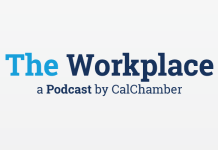In this episode of The Workplace podcast, CalChamber Associate General Counsel Matthew Roberts and Senior Employment Law Counsel Erika Barbara cover common mistakes employers encounter when working with pregnant employees who request leave due to their pregnancy.
At the beginning, Roberts notes that employers can find complying with California and federal laws about pregnant employees to be difficult and confusing because of the variety of state and federal leave and discrimination laws that apply.
For Barbara, understanding the law that applies to pregnant employees is important because these issues have an impact on nearly all businesses at some point. Further, because every pregnant employee has a unique experience, handling any leave or related issues may be a little bit different every time.
Leave Eligibility and Pregnancy Disclosures
California law provides a specific leave of absence for pregnancy-related disabilities known as pregnancy disability leave (PDL) that provides up to four months of job-protected leave, which an employee may request even on their first day of employment.
“So, this often takes employers by surprise,” Barbara says. “There is no eligibility requirement for pregnancy disability leave…employers are eligible for leave from the moment that they are hired.”
Further, Barbara states, this law applies to any employer with five or more employees and includes other provisions such as reasonable accommodations and the potential for job transfers within the organization — highlighting the importance for employers to be aware of these obligations and that they kick in right when the employee is hired.
Because of the immediacy with which a pregnant employee may ask for accommodations or leave, employers often are blindsided and wonder if an applicant or new hire needs to disclose their pregnant condition so that an employer may prepare for these requests.
“[T]here is no requirement that an applicant disclose their pregnancy during the interview process or before they’re hired and, in fact, we don’t want them to do that because pregnancy is a protected characteristic under the law,” Barbara says.
To avoid discrimination claims, employers must evaluate an applicant based upon whether they are qualified for the job and cannot consider a protected characteristic such as pregnancy — even if the applicant voluntarily discloses that they are pregnant.
Four Months Isn’t a Guarantee or a Limit
While California law does provide for up to four months of PDL, employees are not guaranteed this full amount. Barbara states that a common misconception among employees is they get an automatic four months of leave and get to decide when to take that leave.
Employers needn’t rely on employees to dictate when and how much leave they need. “Instead, what we do is require medical certification confirming the need for leave,” Barbara says. From there, employers can determine the leave’s duration based on the statement from the employee’s doctor.
If an employee needs more than the four months of leave because of significant difficulties with their pregnancy or childbirth, the employer needs to consider further disability leave under standard disability rules. Barbara notes that while California Family Rights Act leave is also available for eligible employees, that leave is reserved for child bonding and does not begin until after the pregnancy disability ends.
“Pregnancy disability leave continues after the baby is born because an employee will continue to be disabled for some period after childbirth,” Barbara says. When an employee is recovering after childbirth, they are still within the definition of “disabled by pregnancy.”
Returning to Work Is a Right
Roberts notes that because of the length of time that employees may be out related to their pregnancy disability as well as any subsequent child bonding leave, employers may have transferred that employee’s duties to a temporary employee or several existing employees within the organization and may find that they prefer that arrangement.
Employers must understand, however, that anyone taking job-protected PDL or child-bonding leave must be returned back to their original or a comparable position.
“That really means a position that’s virtually identical in terms of pay, duties, schedule, shift, everything,” Barbara says.
Employers should always consult legal counsel for specific issues related to pregnancy and childbirth.
Employers looking for more guidance and detailed information about PDL and child-bonding leave can utilize CalChamber’s substantial online resources at HR California or consult the CalChamber webinar on demand “What to Expect When Your Employee is Expecting: PDL and Child-Bonding Leave.”
